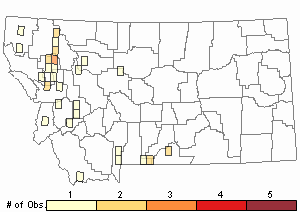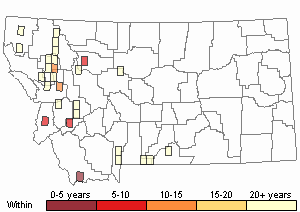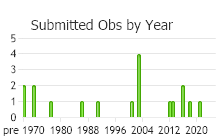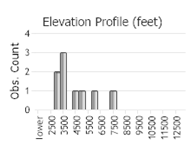View in other NatureServe Network Field Guides
NatureServe
Montana
Utah
Wyoming
Idaho
Wisconsin
British Columbia
South Carolina
Yukon
California
New York
Slender Pear Moss - Leptobryum pyriforme
General Description
Plants: Acrocarpous (Vitt 1988), growing in open clumps of upright shoots or sprinkled further apart, pale green (Lawton 1971), glossy. Stems black, a little bent (Crum & Anderson et al., 1981), usually 5-15 mm in height, seldom to 60 mm (FNA 2014), branching infrequently (Lawton 1971); rhizoids sparse, reddish (Flowers 1973).
Leaves: Slightly bent and twisted when dry, upright to spreading broadly when wet (FNA 2014), the distal and perichaetial leaves longer than the proximal leaves (Flowers 1973), 4-5 mm in length, lance-shaped below, constricting suddenly to form a very slender, long acumen; leaf edges flat, smooth, occasionally finely-toothed close to the leaf tip (FNA 2014); costa nearly filling the upper blade (Flowers 1973), vanishing in the acumen (FNA 2014).
Leaf Cells: Laminal cells slender and long, quadrangular; upper cells longer and a little narrower than the basal cells (FNA 2014).
Range Comments
North American Range
Common (Crum & Anderson et al., 1981). Throughout Canada and the United States (unknown in OK and TX); Mexico (FNA 2014). Known in Montana from Carbon, Carter, Cascade, Flathead, Gallatin, Glacier, Granite, Lake, Lewis and Clark, Lincoln, Madison, Meagher, Missoula, Park, Powell, and Sanders Counties (Elliott & Pipp, 2016).
Observations in Montana Natural Heritage Program Database
Number of Observations: 40
(Click on the following maps and charts to see full sized version)
Map Help and Descriptions
Relative Density

Recency



 (Observations spanning multiple months or years are excluded from time charts)
(Observations spanning multiple months or years are excluded from time charts)
Habitat
Damp soil, less often on decaying wood (Lawton 1971), disrupted habitats (FNA 2014), burned areas, greenhouses and in line with eave drippings (Crum & Anderson et al., 1981).
Reproductive Characteristics
Usually the female and male reproductive organs intermingling, or occasionally appearing to be on separate plants. Seta pear-shaped, short to 4.5 cm tall (FNA 2014). Capsule sloped upward to drooping, shiny and pale to deep brown; neck about half the length of the entire capsule (Lawton 1971), 1.5-2.5 mm in length; peristome teeth 16; cilia of the endostome with crosswise ridges. Calyptra draping hood-like, hairless (FNA 2014), with a long beak, early deciduous (Flowers 1973).
Specialized vegetative reproductive structures borne at leaf junctures and on radicles in the form of red (FNA 2014) to deep purple gemmae (Flowers 1973).
Stewardship Responsibility
References
- Literature Cited AboveLegend:
 View Online Publication
View Online Publication Crum, H.A. and L.E. Anderson. 1981. Mosses of Eastern North America. 2 volumes. Columbia University Press, New York. 1328 pp.
Crum, H.A. and L.E. Anderson. 1981. Mosses of Eastern North America. 2 volumes. Columbia University Press, New York. 1328 pp. Elliott, J.C. and A.K. Pipp. 2018. A Checklist of Montana Mosses (1880-2018). Updated 3 January, 2020. Montana Natural Heritage Program, Helena, Montana. 73 pp.
Elliott, J.C. and A.K. Pipp. 2018. A Checklist of Montana Mosses (1880-2018). Updated 3 January, 2020. Montana Natural Heritage Program, Helena, Montana. 73 pp. Flora of North America Editorial Committee, eds. 2014. Flora of North America North of Mexico. Volume 28. Bryophytes: Mosses, Part 2. Oxford University Press, Inc., NY. xxi + 702 pp.
Flora of North America Editorial Committee, eds. 2014. Flora of North America North of Mexico. Volume 28. Bryophytes: Mosses, Part 2. Oxford University Press, Inc., NY. xxi + 702 pp. Flowers, S. 1973. Mosses: Utah and the West. Brigham Young University, Provo, Utah. 567 p.
Flowers, S. 1973. Mosses: Utah and the West. Brigham Young University, Provo, Utah. 567 p. Lawton, E. 1971. Moss Flora of the Pacific Northwest. Hattori Botanical Laboratory. Japan: Yamabuki-cho, Shinjuku-ku, Tokyo. 362 pages plus appendices.
Lawton, E. 1971. Moss Flora of the Pacific Northwest. Hattori Botanical Laboratory. Japan: Yamabuki-cho, Shinjuku-ku, Tokyo. 362 pages plus appendices. Vitt, D. J. Marsh, and R. Bovey. 1988. Mosses, Lichens & Ferns of Northwest North America. Seattle, WA: University of Washington Press. 296 p.
Vitt, D. J. Marsh, and R. Bovey. 1988. Mosses, Lichens & Ferns of Northwest North America. Seattle, WA: University of Washington Press. 296 p.
- Additional ReferencesLegend:
 View Online Publication
View Online Publication
Do you know of a citation we're missing? Elliot, J. C. 1993. Second checklist of Montana mosses. Unpublished report. U.S. Forest Service, Region 1. Missoula, MT. 45 pp.
Elliot, J. C. 1993. Second checklist of Montana mosses. Unpublished report. U.S. Forest Service, Region 1. Missoula, MT. 45 pp. Lawton, E. 1971. Keys for the Identification of the Mosses on the Pacific Northwest. Reprinted from 'Moss Flora of the Pacific Northwest'. Published as Supplement No. 2 of the Journal of the Hattori Botanical Laboratory. Nichinan, Miyazaki, Japan. 66 pp.
Lawton, E. 1971. Keys for the Identification of the Mosses on the Pacific Northwest. Reprinted from 'Moss Flora of the Pacific Northwest'. Published as Supplement No. 2 of the Journal of the Hattori Botanical Laboratory. Nichinan, Miyazaki, Japan. 66 pp. Malcolm, B., N. Malcolm, J. Shevock, and D. Norris. 2009. California Mosses. Nelson, New Zealand: Micro-Optics Press. 430 pp.
Malcolm, B., N. Malcolm, J. Shevock, and D. Norris. 2009. California Mosses. Nelson, New Zealand: Micro-Optics Press. 430 pp. Smith, A.J.E. 1980. The Moss Flora of Britain and Ireland. Cambridge University Press, Cambridge. 705 pp.
Smith, A.J.E. 1980. The Moss Flora of Britain and Ireland. Cambridge University Press, Cambridge. 705 pp.
- Web Search Engines for Articles on "Slender Pear Moss"





